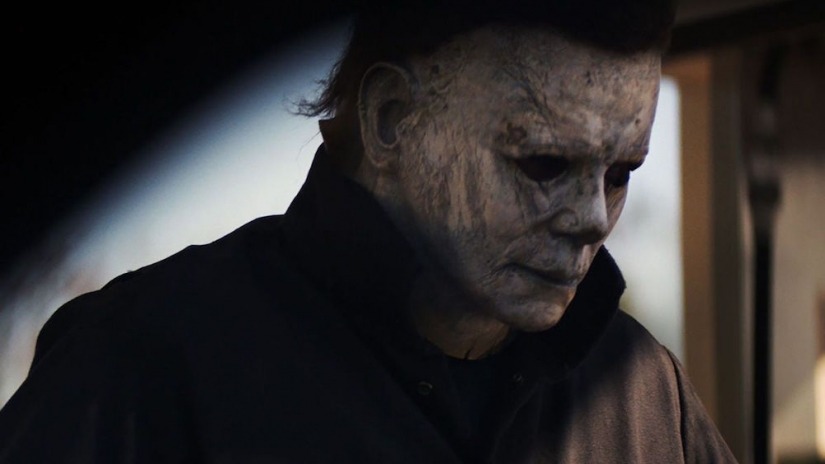
When it was announced we’d receive a new entry in the Halloween franchise on behalf of Blumhouse Productions, I was highly skeptical. While many were excited, knowing that Blumhouse is responsible for the phenomenal films Split (2016) and Get Out (2017), I was too aware they were equally responsible for movies of pitiful quality such as Sinister (2012), Unfriended (2015), and Truth or Dare (2018). Being a massive fan of John Carpenter’s Halloween (1978), I entered the screening of the latest Halloween film with low expectations. Leaving the theater, I was both impressed by the quality of the latest in a long line of sequels, and equally feeling the sting of knowing how close Blumhouse’s Halloween (2018) came to matching if not surpassing the quality of the original film.
Blumhouse’s Halloween picks up 40 years after the events of the original film, as the only survivor of the Babysitter Murders, Laurie Strode (Jamie Lee Curtis), prepares for return of Michael Myers (Nick Castle). When Myers escapes from Smith’s Grove Sanitarium during a transport to a maximum security prison, Strode must confront the entity that’s consumed her life, in hopes that 40 years of planning was enough to prepare her in destroying The Shape.
Straight out of the gate, I can give Blumhouse’s Halloween credit in making Michael Myers genuinely frightening again. This film knows that the best way to craft a horror film is to gradually build up to more terrifying and violent moments as opposed to making the screen a canvas for bloody torture porn. Additionally, the writers understand that Myers is most terrifying when there’s emphasis placed on his intent as a force of nature villain. Like the grim reaper, Myers doesn’t kill with intent, desire, passion, or strategy, he kills because it’s what he does – and it has never felt better.
With John Carpenter’s Halloween being both the origin of many horror conventions and the basic blueprint that served as the foundation of every major slasher film following its release, this film asks a crucial question: what happens to “the final girl” after she survives? The answer is fulfilling in Jamie Lee Curtis’ portrayal of Laurie Strode in Blumhouse’s Halloween. Strode has broken, suffering from PTSD, living with the paranoid fear that Michael’s just waiting to finish the job he started in 1978, and it’s a gripping progression of a once simple character.
Even more compelling is the film’s dualistic fascination with Strode and Myers. Throughout the movie, our protagonist and antagonist are shown as warped reflections of each other, to the point that scenes focused on Strode echo scenes centered on Myers in the original Halloween. It’s both a fascinating theme and a touch of fan service, without getting too obnoxious to distract from the film itself.
As for John Carpenter, he can best be described in two ways: an underrated filmmaker, and an underrated composer, with the later of Carpenter’s professions truly shining in Blumhouse’s Halloween. The soundtrack is like a spider with bladed legs, crawling up your spine, pin-pricking with familiar melodies and new stings at just the right time.
With the amount of praise I’ve levied on Blumhouse’s Halloween, it may be surprising to know that I have equally passionate criticisms for the film. While comedy may be a great tool to help relieve tension in horror, there’s times where this film lets the humor leak into moments of terror to ill effect. It’s especially worst when the humor is neither funny nor helping build on the story. Such is the case with one scene in the final act, where during the tension of Myers’ final descent on the Strode household, the film stops everything to dedicate a scene to two cops sitting in their car debating over lunch.
Moments like these could admittedly be forgiven, but there’s one thing in Blumhouse’s Halloween that truly sullies the entire experience, and it’s what I hesitate to call the film’s “plot twist”. It’s a moment right at the end of the second act which comes out of nowhere, feels entirely out of character, and worst of all, acts only as a contrived Deus Ex Machina with the sole purpose of arranging the final confrontation between Myers and Strode. The ultimate sin a film can commit is sucking a viewer out of the story, and that’s exactly what this plot convenience did. It left me with the sense that this scene was the first thing the writers thought up when confronted with the issue of getting our protagonist and antagonist in the same place for one last fight, and it shows.
To the average moviegoer, Blumhouse’s Halloween will provide an above-average horror story, sufficient scares, and thrills worth the price of admission. My bitter-sweet frustration with this film is that this sequel comes so close to rivaling my favorite slasher film in terms of quality that it pains me to see its glaring issues. Regardless of this conflict, Blumhouse’s Halloween is worth watching both as a standalone film, and as a fitting bookend to one of, if not the best slasher film made to date.
 George Ibarra is a Senior at Florida International University, pursuing a Bachelor’s Degree in English with a minor in Sociology, along with Certificates in Exile Studies and Film Studies.
George Ibarra is a Senior at Florida International University, pursuing a Bachelor’s Degree in English with a minor in Sociology, along with Certificates in Exile Studies and Film Studies.
